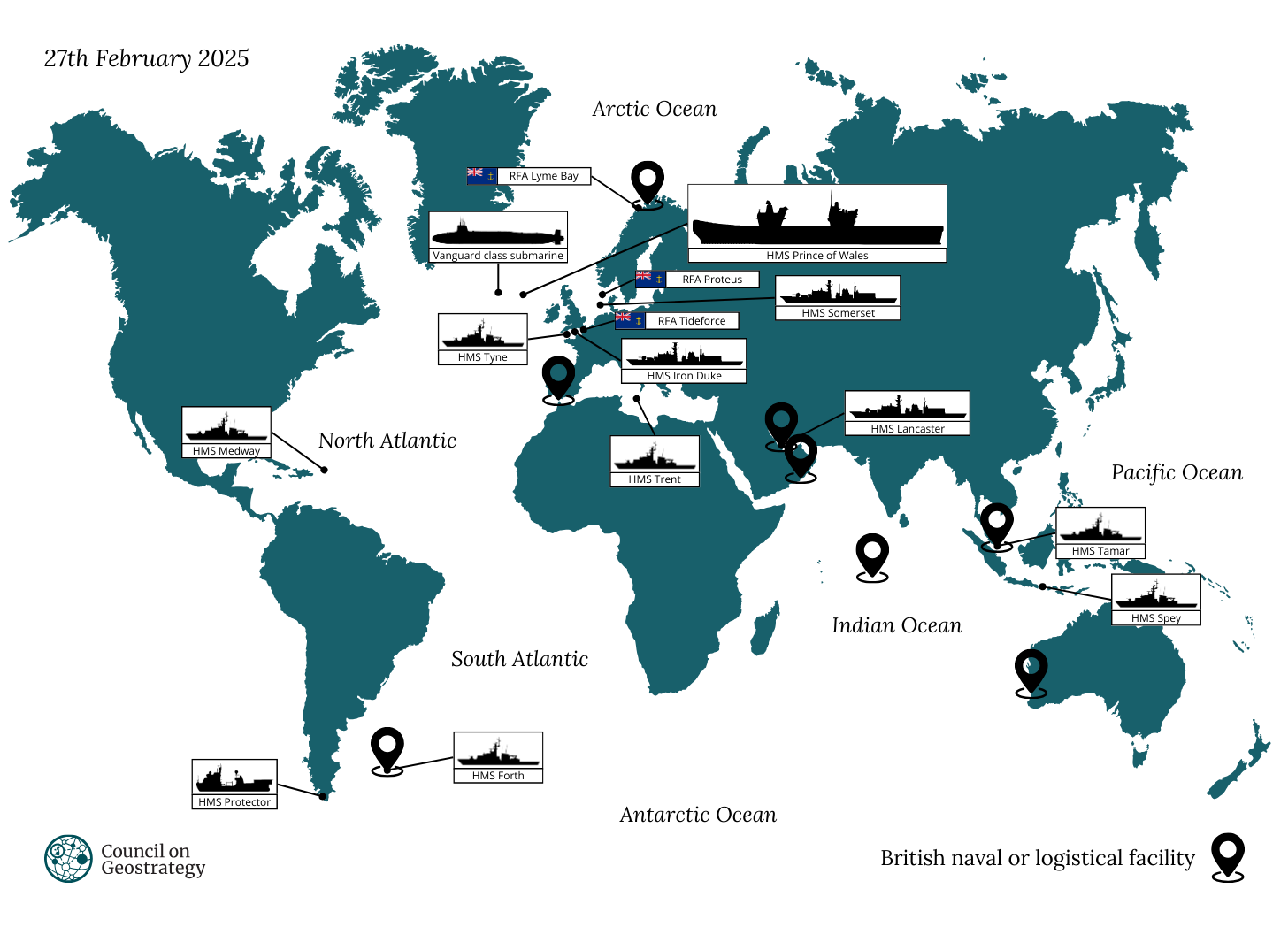
Welcome to The Signal, our new monthly roundup of maritime matters.
Thoughts from your correspondent
Sir Keir Starmer, Prime Minister, confirmed this week that the United Kingdom (UK) will increase defence spending to 2.5% of Gross Domestic Product (GDP) by 2027 and towards 3% by the next Parliament. The way this increase will be spent will be set out in a single national security strategy, to be published before the North Atlantic Treaty Organisation (NATO) summit in June, bringing together the ongoing Strategic Defence Review with the others currently proceeding. Given the pressures that the UK is under, from an aggressive Russia to an unpredictable America, this announcement is most welcome and long overdue.
It won’t be a shock to any of you that I believe that a good portion of this investment should go to the Royal Navy – a naval expert wanting more ships? Of course! But this belief isn’t simply the result of my longstanding love of submarines or my indoctrination by the fine folk of the Royal Navy Strategic Studies Centre. Nor is it predicated on a rosy view of Britain’s seafaring history. The UK needs a strong Royal Navy for far more practical reasons.
Firstly, the core of the nation’s defence is Britain’s continuous at-sea deterrent (CASD) – the submarines and missiles which comprise the nuclear umbrella over British territory, and NATO allies. The UK only has a sea leg of the nuclear triad – with no equivalent air or land capability – so nuclear deterrence is a fundamental Royal Navy responsibility, and one which every person involved takes extremely seriously. While CASD’s funding will probably always be ringfenced by any sensible government, more room for manoeuvre on investment puts the deterrent on a stronger footing.
Secondly, perhaps obviously, comes the old cliché that Britain is an island nation. What this really means is that the UK needs to guard its waters – the Channel, the North Sea, and the Atlantic to the north and west. Given how many Russian ships have been loitering suspiciously around of late (see prior Signals and later on in this issue for more details) this is a particularly salient factor at present. To do this well and sustainably, the Royal Navy needs ships, submarines, drones and people (and the Royal Air Force needs planes and people too, but don’t tell them I said that). All of these require investment – for construction, maintenance, logistics and recruitment.
Thirdly, Britain’s allies rely on its naval power. The heart of the British contribution to any NATO response to a worst-case scenario will be naval – its aircraft carriers, submarines and ships. The Royal Navy is the best in Europe (apologies, Marine Nationale) and should be given the investment to remain so for the sake of Europe. Given the increasingly pressing need for Europe to become more self-sufficient in its own defence, a comprehensive approach tailored around the specialties of each nation would be a wise move. Both because of geography and of capability, such an approach would and should place a significant amount of naval responsibility on the UK. Britain should have a Royal Navy that has the investment behind it to do the job.
We will, of course, have to wait until June to see where His Majesty’s (HM) Government wants to take the Royal Navy, but the defence spending announcement is a welcome step in the right direction. I am hoping for a comprehensive plan for investment that recognises both the short-term necessities and the long-term strategic value of a properly resourced navy. Let’s see if I’m still hopeful in four months’ time!
Tracking the deployments of the Royal Navy
Key movements:
RFA Tideforce, HMS Iron Duke and HMS Tyne shadowed a group of Russian ships passing through the Channel. The warships RFS Aleksandr Otrakovskiy and RFS Ivan Gren were joined by merchant vessels Sparta, Sparta II and General Skobelev and the oiler Yelnya on a journey from the Mediterranean to Russia’s Baltic port, reportedly to evacuate Russian military equipment from Syria following the fall of the Assad regime. It looks like the Royal Navy and Royal Fleet Auxiliary won’t be short of transiting Russian ships to monitor for the foreseeable future.
HMS Somerset took part in the ARCTIC DOLPHIN exercise. The warship and her Merlin helicopter played the part of the enemy in a series of tests for Dutch and Norwegian submarine crews, including high-speed approaches and complex manoeuvres in the confined spaces of the waters along the Norwegian coast. These exercises are incredibly valuable for the Royal Navy – both for enhancing British readiness and cementing ties with close allies.
HMS Cattistock has been undertaking training off the coast of Scotland in preparation for her deployment to Bahrain later this year. The Royal Navy maintains a permanent minehunter presence in the Gulf, so HMS Cattistock will be taking over from sister ship HMS Middleton in the summer.
HMS Sutherland is finally back at sea for trials after an extensive refit. The last of the Type 23 frigates to undergo life extension, the ship has had a wide range of upgrades and refurbishments in a process lasting just over four years – including the replacement of the Sea Wolf missile system with Sea Ceptor. It’s great to see her back afloat!
Maritime news from allies and adversaries
United States (US): Mixed news for the American’s this month. The US Navy successfully tested its HELIOS directed energy weapon system against a cruise missile… and the Nimitz-class aircraft carrier USS Harry S. Truman collided with a commercial vessel just off Port Said. Superficial hull damage only, thankfully – better an embarrassment than a disaster.
People’s Republic of China (PRC): Every month, I seem to bring you updates on another new Chinese vessel, and this edition is no different. This time, it’s quite a surprise: a sail-less submarine spotted in a floating dock. It’s either an unprecedentedly massive uncrewed drone or a new type of crewed submarine – and either way, something to keep a close eye on it.
Iran: The Islamic Revolutionary Guard Corps has taken delivery of its new homegrown drone and helicopter carrier ship, the Shahid Bahman Bagheri. The vessel is a converted commercial ship, with a 180m runway and ski jump for the launch and recovery of drones, plus at least two helicopters. Another ship to watch closely.
NATO: The alliance has successfully tested its capability to integrate uncrewed surface vessels (USVs) into its operational task groups in an exercise in the Baltic Sea. This is an important step forward, and a particularly good sign for NATO’s capabilities in support of the Baltic Sentry mission.
Naval technology news
The first of the Royal Navy’s new Type 31 frigates is expected to be launched this spring. HMS Venturer, the lead of five ships in the class, has been under construction in Rosyth and will be launched into the water for the fitting-out process, with a view to being fully in service by 2027.
The Royal Navy has deployed its new Peregrine Rotary Wing Uncrewed Air System for the first time on drug-hunting operations in the Middle East. Flying from the deck of HMS Lancaster, the mini-helicopter drone performed a series of surveillance sorties, feeding data, live radar picture and imagery directly into the warship’s operations room. Using drones like Peregrine for surveillance means that the ship’s crewed Wildcat helicopter can be kept for interdiction and strike missions. Another step forward in drone operations!
The Royal Navy’s Mine and Threat Exploitation Group have taken delivery of three new underwater drones. The Iver4 580 uncrewed underwater vessels (UUVs) detect threats at increased depths without putting sailors and divers at risk, complementing the autonomous systems already being used as part of the UK’s mine hunting capability (MHC) programme.
More news from Leonardo about their new Proteus uncrewed helicopter – there’s a great summary in Navy Lookout of all the bells and whistles.
Who deserves a mention
One for the Royal Marines this month – I was very touched to read of John Eskdale’s visit to Lympstone. John served with HMS Charybdis in the Mediterranean on the Malta Convoys in 1942 and was involved in the invasion of Sicily in the summer of 1943. He survived the sinking of HMS Charybdis by German torpedo boats near the Channel Islands in late 1943 and went on to see action in Normandy and in the Far East.
To journey at the age of 100 to inspire the next generation of Royal Marines shows how deeply his service matters to him. We are enormously lucky to still have with us a few of those brave souls who defended the UK during the Second World War. BZ to John and all those commandos who follow in his footsteps.
For in this modern world, the instruments of warfare are not solely for waging war. Far more importantly, they are the means for controlling peace. Naval officers must therefore understand not only how to fight a war, but how to use the tremendous power which they operate to sustain a world of liberty and justice, without unleashing the powerful instruments of destruction and chaos that they have at their command.
– Adm. Arleigh Burke, Chief of Naval Operations, 1 August 1961, Change of command address at Annapolis, MD.
A reading list on maritime matters
The winning entries from the Royal Navy’s Lt Cdr Hooper Essay Competition have been published by the team at Wavell Room.
Warship Weapons for Merchant Ship Platforms by T. X. Hammes and R. Robinson Harris in USNI Proceedings – could navies be made bigger by putting missiles and drones on commercial vessels?
South Korea Should Lean into Nuclear-Powered Submarines by Jihoon Yu in War on the Rocks – a well-researched look into South Korea’s submarine programme and why it’s important.
Should Medium Naval Powers Like Chile Have Their Own Shipbuilding Capacity? by Richard Kouyoumdjian Inglis for RUSI – a thought-provoking look at how these powers could address their shipbuilding needs.
If you will once again forgive a toot of my own horn, my latest Council on Geostrategy paper Empowering Britain’s maritime-industrial base is now out, with my recommendations on making the maritime great again.
If you found this Signal useful, please subscribe or pledge your support!
What do you think about this Signal? Why not leave a comment below?













Latest thing I read, the PLAN is building the equivalent of a new Royal Navy every 2 years. I hope the UK really invests in growing the Royal Navy. The US needs all the help it can get in the Indo Pacific.
Another excellent piece, Emma (this simple praise from a fellow submarinophilus and submarine advocate).
Do you feel the eventual 3% target will realistically have the necessary impact on our armed forces? Estimates seem to vary between 3-5%.